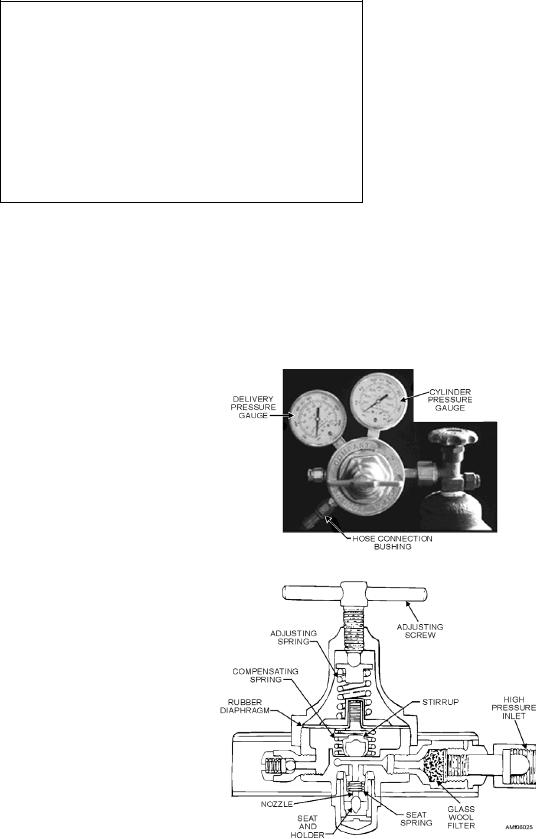
one step; two-stage regulators do the same job in two
of 220 cubic feet at a pressure of 2,000 psi and a
temperature of 70F. Each oxygen cylinder has a
steps or stages. Generally, less adjustment is necessary
when two-stage regulators are used.
high-pressure outlet valve located at the top of the
cylinder, a removable metal cap for the protection of the
Figure 6-25 shows a typical single-stage regulator.
outlet valve during shipment or storage, and a low
The regulator mechanism consists of a nozzle through
melting point safety fuse plug and disk. All oxygen
which the high-pressure gases pass, a valve seat to close
cylinders are painted green for identification. Technical
off the nozzle, and balancing springs. These are all
oxygen cylinders are solid green, while breathing
enclosed in a suitable housing. Pressure gauges are
oxygen cylinders are green with a white band around
provided to indicate the pressure in the cylinder or
the top.
pipeline (inlet), as well as the working pressure (outlet).
The inlet pressure gauge, used to record cylinder
pressures, is a high-pressure gauge and is graduated
CAUTION
from 0 to 3,000 psi. The outlet pressure gauge, used to
record working pressures, is a low-pressure gauge and
Oxygen should never be brought in contact with
is graduated from 0 to 500 psi.
oil or grease. In the presence of pure oxygen, these
substances become highly combustible. Oxygen hose
In the oxygen regulator, the oxygen enters through
and valve fittings should never be oiled or greased or
the high-pressure inlet connection and passes through a
handled with oily or greasy hands. Even grease spots
glass wool filter that removes dust and dirt. Turn the
on clothing may flare up or explode if struck by a
adjusting screw in, to the right, to allow the oxygen to
stream of oxygen.
pass from the high-pressure chamber to the
low-pressure chamber of the regulator, through the
PRESSURE REGULATORS.--The gases com-
regulator outlet, and through the hose to the torch at the
pressed in oxygen and acetylene cylinders are at
pressure shown on the working pressure gauge.
pressures too high for oxyacetylene welding.
Changes in this pressure may be made at will, simply
Regulators are necessary to reduce pressure and control
by adjusting the handle until the desired pressure is
the flow of gases from the cylinders. Most regulators in
registered. Turning the adjusting screw to the right
use are either the single-stage or the two-stage type.
INCREASES the working pressure; turning it to the left
Single-stage regulators reduce the pressure of the gas in
DECREASES the working pressure.
Figure 6-25.--Single-stage oxygen regulator.
6-19

